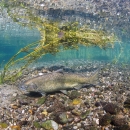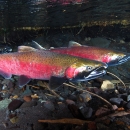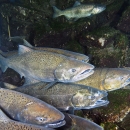About Us
Warm Springs National Fish Hatchery has been a vision of the Confederated Tribes of the Warm Springs Reservation of Oregon since 1959 when the U.S. Fish and Wildlife Service was asked to investigate the possibilities of salmon and steelhead enhancement on the Reservation.
All operations and production at the hatchery are determined through extensive planning and coordination with the Confederated Tribes of the Warm Springs Reservation of Oregon and the U.S. Fish and Wildlife Service in the development of 5 year operational plans. The current plan was the first to be reviewed by the Service's Columbia River Hatchery Review Team. The Review Team found the Warm Springs facility operations was a model for integrated fishery, hatchery, and natural population management.
Our Mission
Since 1871, National Fish Hatcheries have been applying science-based approaches to conservation challenges. We work with our partners and engage the public to conserve, restore, and enhance fish and other aquatic resources for the continuing benefit of the American people. Conservation is at the heart of what we do, and we recognize that we do this work for the American people–both the present generation who benefit today and future generations who will inherit our legacy of conserving America’s aquatic resources.
Our History
Warm Springs Nation Fish Hatchery has been a vision of the Confederated Tribes of Warm Springs Reservation of Oregon since 1959 when the U.S. Fish and Wildlife Service was asked to investigate the possibilities of salmon and steelhead enhancement on the Reservation. The results were a demonstration that wild spawning grounds were underutilized due to dam passage problems. In 1963 the Tribe requested the U.S. Fish and Wildlife Service conduct a hatchery feasibility study on the reservation. Congress authorized the construction of the Warm Springs Hatchery in 1966. The hatchery is operated by the U. S. Fish and Wildlife Service on lands leased from Confederated Tribes of the Warm Springs Reservation of Oregon and co-managed by both. This hatchery is somewhat unique in that it was not built for mitigation but specifically for supplementation.
A hatchery master plan was developed in 1971 with the first operational plan in 1977 and production initiated in 1978. Initial production included spring Chinook, summer steelhead, and rainbow trout. Steelhead production was dropped in 1981 (disease, growth and facility physical limitations) and rainbow production was dropped in 1999 (thought to limit the native red-band rainbows). Today the facility target production is 750,000 spring Chinook smolts released each year.
Other Facilities in this Complex
We're part of the Columbia River Gorge National Fish Hatchery Complex, which includes the Carson, Eagle Creek, Little White Salmon, Spring Creek, Warm Springs, and Willard National Fish Hatcheries. Our complex propagates, releases, and transfers to partners over 25 million salmon to meet the U.S. Fish and Wildlife Service's fisheries mitigation, restoration, and tribal trust responsibilities. Explore what each facility has to offer below.





